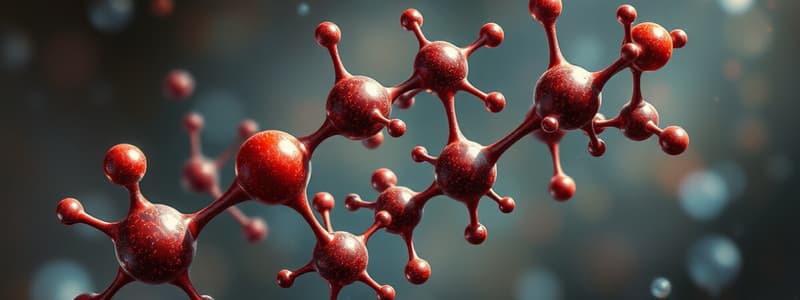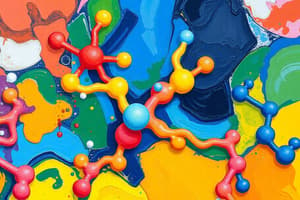Podcast
Questions and Answers
What is a biomolecule?
What is a biomolecule?
Any carbon-based (organic) molecule that is produced by a living organism.
What type of bonds can carbon atoms form with up to four other atoms?
What type of bonds can carbon atoms form with up to four other atoms?
Covalent bonds.
What is organic chemistry the study of?
What is organic chemistry the study of?
All compounds that contain bonds between carbon atoms.
What are monomers?
What are monomers?
What are polymers made of?
What are polymers made of?
Mono refers to _____
Mono refers to _____
Poly refers to _____
Poly refers to _____
Meros means _____
Meros means _____
What are monomers and polymers sometimes called?
What are monomers and polymers sometimes called?
What are the four main types of biomolecules?
What are the four main types of biomolecules?
What are examples of carbs?
What are examples of carbs?
What is a carbohydrate made up of?
What is a carbohydrate made up of?
What is the formula for a carbohydrate?
What is the formula for a carbohydrate?
What is the ratio of carbohydrates?
What is the ratio of carbohydrates?
What are starches and sugars a main source of?
What are starches and sugars a main source of?
For what purposes do plants and some animals use carbohydrates?
For what purposes do plants and some animals use carbohydrates?
What are single sugar molecules called?
What are single sugar molecules called?
What is a saccharide?
What is a saccharide?
What are double sugar molecules called?
What are double sugar molecules called?
Di refers to _____
Di refers to _____
What are more than two sugar molecules called?
What are more than two sugar molecules called?
What method joins monosaccharides together?
What method joins monosaccharides together?
What is the reverse of dehydration synthesis?
What is the reverse of dehydration synthesis?
What does cellular respiration produce?
What does cellular respiration produce?
What are sugars used in the process of?
What are sugars used in the process of?
What is starch produced by?
What is starch produced by?
Why do starches take up less space in a cell?
Why do starches take up less space in a cell?
What are starches broken down by organisms to release?
What are starches broken down by organisms to release?
What do animals store excess sugar in the form of?
What do animals store excess sugar in the form of?
What do plants store excess sugar in the form of?
What do plants store excess sugar in the form of?
What do plants use for strength and rigidity?
What do plants use for strength and rigidity?
What are totaled together on a nutrition label?
What are totaled together on a nutrition label?
What is a lipid?
What is a lipid?
What are examples of lipids?
What are examples of lipids?
Lipids are made mostly from which two atoms?
Lipids are made mostly from which two atoms?
What are lipids made of?
What are lipids made of?
What can lipids be used to do for the organism?
What can lipids be used to do for the organism?
What do lipids build?
What do lipids build?
What helps maintain homeostasis?
What helps maintain homeostasis?
What are the most commonly consumed lipids in animal diets?
What are the most commonly consumed lipids in animal diets?
What do triglycerides provide twice the energy of?
What do triglycerides provide twice the energy of?
What are the names used for triglycerides when they make fats?
What are the names used for triglycerides when they make fats?
Flashcards are hidden until you start studying
Study Notes
Biomolecules Overview
- Biomolecules are organic compounds produced by living organisms, primarily made of carbon.
- Four main types of biomolecules: carbohydrates, lipids, proteins, and nucleic acids.
Chemical Foundations
- Covalent bonds allow carbon to connect with up to four other atoms, crucial for the complexity of biological molecules.
- Organic chemistry focuses on the structure, properties, and reactions of carbon-containing compounds.
Structure of Biomolecules
- Monomers are individual subunits, while polymers consist of multiple monomers.
- Macromolecules are large molecules formed from monomers and polymers.
Carbohydrates
- Composed of carbon, hydrogen, and oxygen; follows the formula Cn(H2O)n with a 1:2:1 ratio.
- Starch and sugars serve as primary energy sources and have structural roles in plants and some animals.
- Monosaccharides are single sugar units (e.g., glucose, galactose, fructose).
- Disaccharides consist of two monosaccharides (e.g., sucrose, lactose, maltose).
- Polysaccharides are formed from multiple sugars, including starch, cellulose, glycogen, and chitin.
- Dehydration synthesis links monosaccharides, while hydrolysis breaks them apart.
- Glycogen serves as a form of energy storage in animals; starch does the same in plants.
- Cellulose fiber provides structural strength and rigidity to plant cells.
Nutrition Labeling
- Total carbohydrates include both sugars and starches on nutrition labels.
Lipids
- Lipids include fats, oils, waxes, and vitamins, primarily composed of carbon and hydrogen.
- Built from a glycerol molecule and three fatty acids.
- Function in energy storage for organisms, providing twice the energy of carbohydrates or proteins.
- Essential for building cell membranes and maintaining homeostasis through phospholipid bilayers.
- Commonly consumed lipids in diets are triglycerides, which are categorized into saturated, mono-unsaturated, and poly-unsaturated fats.
Studying That Suits You
Use AI to generate personalized quizzes and flashcards to suit your learning preferences.




